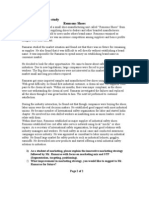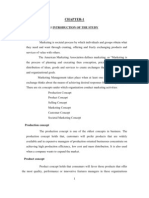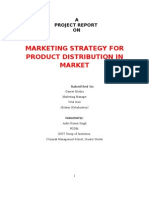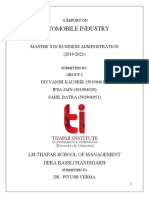Bba Syllabus 5th Sem
Bba Syllabus 5th Sem
Uploaded by
Kiran KaurCopyright:
Available Formats
Bba Syllabus 5th Sem
Bba Syllabus 5th Sem
Uploaded by
Kiran KaurCopyright
Available Formats
Share this document
Did you find this document useful?
Is this content inappropriate?
Copyright:
Available Formats
Bba Syllabus 5th Sem
Bba Syllabus 5th Sem
Uploaded by
Kiran KaurCopyright:
Available Formats
FIFTH SEMESTER BBA (CAM) SALES AND DISTRIBUTION MANAGEMENT Course Code: BBA (CAM) 301 L:4 T/P:
: Credits: 4
PREAMBLE: The primary objective of the course is to familiarize the student with the sales operations and sales management functions and customer relationship management. Endeavor is to provide both theoretical inputs and applications of practical aspects. COURSE CONTENT: UNIT 1: Credits 10 Managing and Planning Sales The field of Sales Management: Concept, Evolution of Professional Selling, Objectives of Sales Management, Exchange Process, Key Decision areas in Sales Management, Sales Management Cycle. Sales Strategy Formulation: Market Analysis, Setting Sales Objectives, Designing Sales Strategy. Planning for Selling efforts: Personal selling Concept, Situations conducive to personal Selling, Diversity Of Personal Selling situations, Strategies Used by Salesmen, Process of Personal Selling, Choice of basic Selling Style,New Approaches in Selling UNIT 2: Personal Selling: AIDAS Theory of selling "Rights set of Circumstances" Theory "Buying Formula " Theory Behavioural Equation" Theory Salesmanship and Sales-Promotion concept Essential Qualities of a Successful Salesman. Motivating & Compensating Sales Personnel Motivation "Help from Management" Financial Motivational Techniques Non-Financial Motivational Techniques Devising a Sales Compensation Plan Types of Compensation Plans Fringe Benefits Negotiating skills Credits 10
UNIT 3: Sales Control Sales Expenses Management Reimbursement of Sales expenses, policies & practices Sales Budgeting and Control Preparation of sales Budget Budget implementation & feedback mechanism Sales Control Sales Meetings & Contests Planning & Staging of sales meetings Sales Contests, Specific Objectives Contest Prizes Managerial Evaluation of Contests UNIT 4: Relationship Management Customer Relationship Applications of Relationship Marketing Marketing Strategy Internal Marketing Ethics in Sales Management Ethics Defined Factors influencing the Ethics of Sales People Primary Areas Served by Ethics of Sales Management
Credits 10
Credits 10
TEXT BOOKS: 1. Service Marketing-M.K.Rampal & S.L. Gupta (R&G)-Galgotia Publications 2. Sales & Distribution Management- Dr. Matin Khan (MK)- Excel Books. REFERRENCE BOOKS: 1. Sales & distribution Management- SL Gupta (SLG) -Excel Books 2. Negotiating , Persuading and Infiuencing-Alan Flower (AF)
FIFTHSEMESTER BBA (CAM) FINANCIAL MANAGEMENT Course Code: BBA (CAM) 303 Objective The objective of the course is to acquaint the students with the overall framework of financial decision-making in a business unit. Course Contents: Unit I Financial Management: Meaning, Scope, Objectives of Financial Management Profit Vs. Wealth Maximization, Financial Management and other Areas of Management, Liquidity Vs. Profitability, Methods of Financial Management, Organization of Finance Function. Concepts in Valuation: Time Value of Money, Valuation Concepts, Valuation of Securities viz., Debentures, Preference Shares and Equity Shares. HOURS 8 Unit II Capital Budgeting: Concept, Importance, Appraisal Methods: Pay back period, DCF techniques, Accounting rate of return, Capital Rationing, Concept of Risk, Incorporation of Risk Factor, General Techniques: Risk adjusted discount return, certainty equivalent coefficient and Quantitative Techniques: Sensitivity analysis, Probability assignment, Standard deviation, Coefficient of variation, Decision tree. Cost of Capital: Concept, Importance, Classification , and Determination of Cost of Capital. Leverages: Concept, Types of leverages and their significance. HOURS 16 L: 4 T-0 Credits: 4
Unit III Capital Structure: Meaning, Capital Structure and Financial Structure, Patterns of Capital Structure, Optimum Capital Structure, Capital Structure Theories, Factors Determining Capital Structure, Capital Structure Practices in India. HOURS 8 Unit IV Sources of Finance: Classification of Sources of Finance, Security Financing, Loan Financing, Project Financing, Loan Syndication- Book Building, New Financial Institutions and Instruments viz., Depositories, Factoring, Venture Capital, Credit Rating, Commercial Paper, Certificate of Deposit, Stock Invest, Global Depository Receipts. Dividend, Bonus and Rights: Dividend Policy, Relevance and Irrelevance Concepts of Dividend, Corporate Dividend Practices in India. Working Capital Management: Concept, Management of Cash, Management of Inventories, Management of Accounts Receivable and Accounts Payable, Over and Under Trading. HOURS 12 Suggested Readings: 1. 2. 3. 4. 5. 6. 1. Maheshwari, S.N.; Financial Managemen, Principles and Practice, Sultan Chand & sons, 9th Edition 2004. 2. Maheshwari, S.N.; Elements of Financial Management, Sultan Chand & Sons, 2003 7th Edition. 3. Van C. Horne; Financial Management and Policy, Prentice Hall of India., 11th Edition 2002. 4. Pandey, I.M.; Financial Management, Vikas Publishing House, 8th Edition, 2001. 5. Khan, M.Y. & P.K. Jain; Financial Management, Tata McGraw Hill, 2001 3rd Edition. 6. Hampton, John. J.; Financial Decision Making, Prentice Hall of India, 4th Edition, 1998.
FIFTH SEMESTER BBA (CAM) CONSUMER BEHAVIOUR Course Code: BBA (CAM) 305 L:4 T/P: Credits: 4
Preamble: In the era customer Satisfaction and customer delight it is very important to understand the behaviour of the customers. The course is designed to enable the various individual and organisational aspects that influence the buying decisions of the customer. COURSE CONTENT: UNIT 1: Introduction To Consumer Behaviour Definition of C.B Consumer Buying Process Importance of C.B Approaches to Study C.B Basic Model Of C.B Stages of Buying Process Industrial Buying / Organization Buying Current Trends in C.B Consumer Behavior from Consumer Perspective HOURS 10
UNIT 2: Determinants to Consumer Behaviour 1. Attitude a) a) Models and theories of attitude b) b) Change in Attitude 2.Personality and self concept a)Nature of personality b)Theories of personality(Freudian ,Jungian,Neo-Freudian&Trait theory) c)Personality and understanding consumer diversity d)Self and self Image UNIT 3: Influences to Consumer Behaviour
HOURS 10
HOURS 10
i) Culture Characterstics of Culture Defnamism of Culture Relevance of Sub Culture and Cross Culture on CB Indian Culture and Sub Culture Marketing Srategies and problems related to cross culture ii) Social Class Determinants of Social Class Objective Approach Composite Variable Indices Social Class Mobility Applications Of social class to consumption iii) Family and life style Significance Family life cycle stages Influences on life cycle Applications of AIO Studies VALS system of classification UNIT 4: Consumer Decision Making a) b) c) d) e) HOURS 10
Process of Consumer Decision Making b) Complex Decision Making c) Types of C. Purchasing Decision d) Consumer Involvement and CDM e) A Basic Model Of Decision Making (Need Arousal C.I Process Brand Evaluation Purchase and Post Purchase Behavior)
TEXT BOOKS:
1. Consumer Behavior Leon G.Schiffman,Leslie Lazar Kanuk(SCH) Prentice Hall of India Private Limited 2. Consumer Behaviour Dr.S.L.Gupta &Sumitra Paul(SLG&SP) Sultan Chand &sons Educational Publishers REFERENCE BOOK: Consumer Behavior Henry Assael(HA)Asian Books Private Ltd.
FIFTH SEMESTER BBA (CAM) MANAGEMENT INFORMATION SYSTEM Course Code: BBA (CAM) 307 L:4 T/P: Credits: 4
PREAMBLE: The objective of the course is to acquaint the students about the concept of information system in business organisations, and also the management control systems. UNIT-I Hours:12
Introduction : Definition, Purpose, Objectives and Role of MIS in Business Organisation with particular reference to Management Levels. MIS Growth and Development, Location of MIS in the Organisation - concept and design. Transaction Processing System, Decision Support System, Executive Information System, Expert System, and the recent developments in the field of MIS. UNIT-II Hours:10 System Development : Concept of System, Types of Systems - Open, Closed, Deterministic, Probabilistic, etc. Relevance of choice of System in MIS, Integration of Organisation Systems and Information Systems, System Development Life Cycle, System Analysis, Design and Implementation, MIS Applications in Business. UNIT-III Hours : 8
Information Concepts : Data and Information - meaning and importance, Relevance of Information in Decision Making, Sources and Types of Information, Cost Benefit Analysis - Quantitative and Qualitative Aspects, Assessing Information needs of the Organisation. UNIT-IV Hours : 14 Information Technology : Recent Developments in the Field of Information Technology Multimedia Approach to Information Processing. Decision of Appropriate Information Technology for proper MIS, Choice of appropriate IT systems Database, Data warehousing & Datamining Concepts, Centralised and Distributed Processing
Text Book: 1. Management Information System- W.S. Javadekar- Tata Magraw Hill Publication Reference Books: 1. Information Systems for Managers Arora, Ashok and Akshaya Bhatia Excel Books, New Delhi Basandra, Suresh K. Wheeler Publishing New Delhi. Awad
2.
Management Information Systems
3.
System analysis and design
FIFTH SEMESTER BBA (CAM) WEB DESIGNING & DEVELOPMENT Course Code: BBA (CAM) 309 PREAMBLE To familiarize the students with various Web based packages to develop customize web site. UNIT-I HOURS 10 A) An introduction to the World Wide Web i) i) Concepts of web technology ii) ii) Web browsers iii) iii) Internet and Intranet iv) iv) Protocols the TCP/IP, HTTP, FTP, SMTP Planning your web site i) i) Doing business on the web ii) ii) An overview of internet commerce providers iii) iii) A search engine iv) iv) Forming a project team v) v) Setting goals and objectives vi) vi) Developing the right business strategy HTML i) i) ii) ii) iii) iii) iv) iv) v) v) vi) vi) vii) vii) viii) viii) ix) ix) What is HTML HTML basics Document tags Container and empty tags Entering paragraph text on your web page The <BR> tag The comment tag Working with HTML text Emphasing text implicitly and explicitly L:4 T-0 Credits: 4
B)
C)
x) xi) xii) xiii) xiv) xv) xvi) xvii) xviii) xix) xx) D)
x) xi) xii) xiii) xiv) xv) xvi) xvii) xviii) xix) xx)
The <Block quote> element Using <Pre> tag The <Dir> tag The <Font> tag The <Base font> tag Using lists in web documents Nested ordered Unordered lists Menu lists Directory list Definition list
Graphics for web pages i) i) <img> tag ii) ii) Scaling down an image iii) iii) Adding entire images to web pages iv) iv) Working with links v) v) Relative and absolute link vi) vi) Link tag Tables, frames and forms i) i) Creating borderless tables ii) ii) Frames iii) iii) Forms UNIT-II HOURS 10
E)
F)
Java script i) i) ii) ii) iii) iii) iv) iv) v) v) vi) vi) vii) vii) viii) viii) ix) ix) x) x) xi) xi) xii) xii) xiii) xiii) xiv) xiv) xv) xv) xvi) xvi)
Introduction to client-side scripting Java Script JavaScript and data Types of scripts Conversion of functions Arrays Operations Statements Function Objects Events Window events Image events The window object Opening and closing windows Communicating with the user
G)
xvii) xvii) Displaying information on the status bar xviii) xviii) Working with time sets xix) xix) The frame object xx) xx) The document object xxi) xxi) The form object xxii) xxii) Math object Introduction to Active Server Pages i) i) Introduction ii) ii) What exactly is an Active Server Page (ASP) iii) iii) Applications of Active Server Pages iv) iv) Elements of Active Server Pages v) v) Function of ASP vi) vi) Operators vii) vii) Event-driven programming viii) viii) Query string ix) ix) ASP objects x) x) Database management through ASP UNIT-III HOURS 10
A)
B)
C)
Introduction to Dreamweaver i) i) Introduction ii) ii) What is dreamweaver iii) iii) Interfaces iv) iv) The property inspector v) v) Setting properties for web page vi) vi) Text formatting Working with links & multimedia i) i) Adding hyperlink in webpages ii) ii) Relative and absolute path iii) iii) Working with bookmarks iv) iv) Mailto link v) v) Working with images vi) vi) Aligning image with text vii) vii) Image mapping viii) viii) Creating rollover Tables and frames i) i) Create table ii) ii) Add and remove rows and columns iii) iii) Nesting tables iv) iv) Import table data v) v) Sorting data vi) vi) Export data from a table vii) vii) Formatting tables viii) viii) Overview of frames
ix) x) xi)
ix) x) xi)
Inserting a frameset Nested frameset Attributes of frames HOURS 10
UNIT-IV A) Introduction to flash i) i) Introduction ii) ii) Flash-6 new features iii) iii) Flash 6 Vs Flash 5.0 iv) iv) Flash 6 in details v) v) Layers vi) vi) Drawing with flash vii) vii) Creating contents viii) viii) Grouping shapes ix) ix) Types and text effects x) x) Creating symbols and movie clips xi) xi) Animating with flash xii) xii) Editing animation Advanced Flash i) i) Interacting with flash ii) ii) Action script iii) iii) Programming with action script iv) iv) Flash and HTML v) v) Standalone players and projector vi) vi) Flash generator vii) vii) Flash generator server and template viii) viii) Generator output window ix) ix) Site designing with flash
B)
Text Books: i) i) HTML, DHTML & Javascript-Evan Bayross ii) ii) ASP in 21 days Techmedia Reference Books: i) ii) iii) i) ii) iii) Dreamwearer in 21 days-Techmedia ASP 2.0 unleashed HTML 4.0 unleashed
FIFTH SEMESTER BBA (CAM) BUSINESS POLICY & STRATEGY Course Code: BBA (CAM) 311 L:4 T/P: Credits: 4
Objective: This course is intended to acquaint the students with the nature Business Policy and Strategy. I. I. Introduction: Nature, scope and importance of the course on Business Policy; Evolution of this course Forecasting, Long-range planning, strategic planning and strategic management. Strategic Management Process: Formulation Phase vision, mission, environmental scanning, objectives and strategy; implementation phase Strategic Activities, Evaluation and Control. HOURS 10 II. II. Environmental Analysis: Need, Characteristics and categorization of environmental factors; approaches to the environmental scanning process structural analysis of competitive environment; ETOP a diagnosis tool. HOURS 8
III.
III. Analysis of Internal Resources: Strengths and Weakness; Resource Audit; Strategic Advantage Analysis; Value-Chain Approach to Internal Analysis; Methods of analysis and diagnosing Corporate Capabilities Functional Area Profile and Resource Deployment Matrix, Strategic Advantage Profile; SWOT analysis. HOURS 10 IV. Formulation of Strategy: Approaches to Strategy formation; major strategy options Stability, Growth and Expansion, Diversification, Retrenchment, Mixed Strategy; Choice of Strategy BCG Model; Stop-Light Strategy Model; Directional Policy Matrix (DPM) Model, Product/Market Evolution Matrix and Profit Impact of Market Strategy (PIMS) Model; Major Issues involved in the Implementation of strategy: Organization structure; leadership and resource allocation. HOURS 12
IV.
Suggested Readings: 1. 1. Wheelen, Thomas L. and J. David Hunger; Strategic Management and Business Policy: Emerging, 21st Century Global Society, 7th ed., Prentice Hall, New Jersey, 2000. 2. Ghosh, P. K.; Strategic Planning and Management, Sultan Chand & Sons, New Delhi, 8th ed., 2000. 3. Kazmi, Azhar; Business Policy, Tata McGraw-Hill, New Delhi, 2000.
2.
3. 4.
4. Thompson, Arthur A. and A. J. Strickland; Strategic Management, McGraw Hill, New York, 1999. 5. Hill. Jauch and Glueck; Business Policy and Strategic Management, McGraw-
5.
6.
6. Rao, P. Subba; Business Policy and Strategic Management, Himalaya Publishing House, 1st ed., 1999.
7.
7. McCarthy, Minichiello & Curran; Business Policy and Strategy: Concepts and Readings, Richard D. Irwin and AITBS, Delhi, 4th ed., 1996. 8. Ansoff, H. Igor; Corporate Strategy, Penguin.
8.
FIFTH SEMESTER BBA (CAM) INDUSTRIAL TRAINING/PROJECT Course Code: BBA (CAM) 313 L:0 T-4 Credits: 10
Each student shall undergo for industrial training of twelve weeks duration after the end of Fourth semester in an approved business/industrial/service organization and submit at least two copies of the Industrial Training Report to the head of the Institution at least two weeks before the commencement of End Term Examination of Sixth Semester. Alternatively, they shall pursue Industrial project under the guidance of an internal supervisor to be appointed by the Director/Principal of the concerned Institution.
This Industrial training report/Industrial project report shall carry 100 marks and it shall be evaluated in two parts. By the External Examiner appointed by the University for 50 marks and by an internal Board of examiners to be appointed by the Director/Principal of the Institute. And it shall be comprised of minimum of two nInternal Faculty members. Of them, as far as possible, one of them shall be industrial supervisor in case of industrial projects.
FIFTH SEMESTER BBA (CAM) WEB DESIGNING & DEVELOPMENT LAB Course Code: BBA (CAM) 351 L:0 T-4 Credits: 2
The Lab. will be based on BBA(CAM)- 309 : Web Designing and Development REFERENCE BOOKS: 1. HTML, DHTML & Javascript-Evan Bayross 2. ASP-2.0 Unleashed Techmedia
You might also like
- Literature Review On Advertising and Sales PromotionDocument8 pagesLiterature Review On Advertising and Sales PromotioneldcahvkgNo ratings yet
- Industrial Marketing Case StudiesDocument2 pagesIndustrial Marketing Case Studiesagatre200767% (6)
- User Defined Attributes in Oracle PIMDocument17 pagesUser Defined Attributes in Oracle PIMVinayNo ratings yet
- Internship ReportDocument37 pagesInternship ReportMicky Gautam100% (1)
- How Should The Ideal Channel For Distributing Pesticides Be DesignedDocument2 pagesHow Should The Ideal Channel For Distributing Pesticides Be DesignedanketayaNo ratings yet
- Service Manual Konica 1015Document24 pagesService Manual Konica 1015Colesniuc Alin50% (2)
- Mcom II MGMT Retail Management Practice QuestionsDocument3 pagesMcom II MGMT Retail Management Practice QuestionsAryan MehtaniNo ratings yet
- Bellad Motors ProjectDocument96 pagesBellad Motors ProjectVikram DevarapalliNo ratings yet
- Marketing ProjectDocument15 pagesMarketing ProjectShretha lakshmi rNo ratings yet
- My Marketing Sip ProjectDocument55 pagesMy Marketing Sip ProjectNidhi BaranwalNo ratings yet
- SynopsisDocument8 pagesSynopsisAkhin SanjuNo ratings yet
- Facebook ProjectDocument26 pagesFacebook ProjectPrathamNo ratings yet
- Project On TVS APACHEDocument65 pagesProject On TVS APACHEyasirrk75% (4)
- A Study of Consumer Preference For Prefume & Deodorant Brands Available in Ghazipur CityDocument26 pagesA Study of Consumer Preference For Prefume & Deodorant Brands Available in Ghazipur CityAnonymous kfPZ5D100% (1)
- Minor Project Report BritanniaDocument50 pagesMinor Project Report BritanniaSaurabh MishraNo ratings yet
- Dainik JagranDocument13 pagesDainik JagranDiamond HeartNo ratings yet
- A Project Report: "A Study On Effectiveness of Digital Marketing For Ilp Overseas"Document53 pagesA Project Report: "A Study On Effectiveness of Digital Marketing For Ilp Overseas"Roy SybariticNo ratings yet
- Mcq-For-Sdm - 2Document52 pagesMcq-For-Sdm - 2jaitripathi2667% (3)
- WDD Practical File 1Document24 pagesWDD Practical File 1Vaibhav SharmaNo ratings yet
- Renualt Kwid Case Study - Group 4Document5 pagesRenualt Kwid Case Study - Group 4Sahil GoyalNo ratings yet
- Swot Analysis InfosysDocument17 pagesSwot Analysis InfosysAlia AkhtarNo ratings yet
- Question Bank On SALES & DISTRIBUTION MANAGEMENTDocument27 pagesQuestion Bank On SALES & DISTRIBUTION MANAGEMENTganeshNo ratings yet
- Management in Action - Social Economic and Ethical Issues (MGMT705)Document5 pagesManagement in Action - Social Economic and Ethical Issues (MGMT705)Aman KumarNo ratings yet
- BritanniaDocument65 pagesBritanniaRaja Krishnan67% (3)
- Namaste India FRPDocument19 pagesNamaste India FRPShruti SaxenaNo ratings yet
- A Project Report On: "A Study On The Effectiveness of Online Marketing With Special Reference To Amazon''Document66 pagesA Project Report On: "A Study On The Effectiveness of Online Marketing With Special Reference To Amazon''kharitamilNo ratings yet
- MCQS Marketing ManagementDocument23 pagesMCQS Marketing ManagementViên NgôNo ratings yet
- Ganesh ProjectDocument61 pagesGanesh ProjectLakhan SharmaNo ratings yet
- Marketing Analysis of Dell and HPDocument27 pagesMarketing Analysis of Dell and HPVihaan VadnereNo ratings yet
- NMIMS Assignment Answer Sheet Dec 2023Document62 pagesNMIMS Assignment Answer Sheet Dec 2023Palaniappan NagarajanNo ratings yet
- Marketing Strategy For Product Distribution in Market: A Project Report ONDocument76 pagesMarketing Strategy For Product Distribution in Market: A Project Report ONbalirajsingh100% (1)
- Report On Automobile IndustryDocument16 pagesReport On Automobile IndustryDivyansh KaushikNo ratings yet
- Idea CellularDocument12 pagesIdea CellularManisha GuptaNo ratings yet
- Objectives of International PricingDocument3 pagesObjectives of International Pricingविशाल गुप्ताNo ratings yet
- 1.2 The Anatomy of Ecommerce Applications: The Various Applications AreDocument2 pages1.2 The Anatomy of Ecommerce Applications: The Various Applications Aremahesh_gottapu100% (1)
- Att - 1440423357377 - Arun Uas Final ReportDocument32 pagesAtt - 1440423357377 - Arun Uas Final ReportArunKumar100% (1)
- Digital Marketing HyundaiDocument4 pagesDigital Marketing HyundaiMohmmedKhayyumNo ratings yet
- Mahindra & Mahindra by Manish Kumar RajpootDocument17 pagesMahindra & Mahindra by Manish Kumar RajpootManish Kumar Rajpoot100% (1)
- Project Report (Team-A) Bcom (Gen)Document47 pagesProject Report (Team-A) Bcom (Gen)Siddharth SiddhuNo ratings yet
- Questionnaire For Pharmaceutical DealersDocument3 pagesQuestionnaire For Pharmaceutical DealersMj PayalNo ratings yet
- Sales & Distribution of Pepsico: Summer Internship Project Report OnDocument54 pagesSales & Distribution of Pepsico: Summer Internship Project Report Onsubhankar daNo ratings yet
- Maggi With OtherDocument55 pagesMaggi With OtherRavi JoshiNo ratings yet
- On Branding DecisionDocument15 pagesOn Branding Decisionmittal_anish100% (1)
- Marketing Mix in Shukla IndustriesDocument65 pagesMarketing Mix in Shukla IndustriesBirjesh KumarNo ratings yet
- Employee Satisfaction and Perception Towards InfowizDocument34 pagesEmployee Satisfaction and Perception Towards InfowizShubham kumarNo ratings yet
- OnidaDocument38 pagesOnidapmalgiNo ratings yet
- HCL Info System FinalDocument56 pagesHCL Info System FinalKaramjeet RaiNo ratings yet
- Voltas Air Conditioners MumbaiDocument64 pagesVoltas Air Conditioners MumbaiBHARATNo ratings yet
- Project Report On Hyundai Santro For MarketingDocument41 pagesProject Report On Hyundai Santro For MarketingHarshad Patel33% (3)
- Media Planning ObjectivesDocument13 pagesMedia Planning ObjectivesSudhanshu JaiswalNo ratings yet
- Brand Loyalty of Airtel... FNALDocument49 pagesBrand Loyalty of Airtel... FNALIrfan KhanNo ratings yet
- Service Marketing - IGNOUDocument11 pagesService Marketing - IGNOUmanas0% (1)
- MKTC642 Part 2Document2 pagesMKTC642 Part 2surajmishra1985No ratings yet
- About JK TyreDocument10 pagesAbout JK TyreAshish Adholiya0% (1)
- A Study of Firozabad Bangle IndustryDocument5 pagesA Study of Firozabad Bangle IndustrySmriti TripathiNo ratings yet
- Business EconomicsDocument7 pagesBusiness EconomicsRejith Chandran100% (1)
- Index: A Study On Marketing Promotion Strategies Adopted by Cadbury Dairy Milk With Reference To Gondia RegionsDocument42 pagesIndex: A Study On Marketing Promotion Strategies Adopted by Cadbury Dairy Milk With Reference To Gondia RegionsujwaljaiswalNo ratings yet
- Green Products A Complete Guide - 2020 EditionFrom EverandGreen Products A Complete Guide - 2020 EditionRating: 5 out of 5 stars5/5 (1)
- Marketing Information System A Complete Guide - 2020 EditionFrom EverandMarketing Information System A Complete Guide - 2020 EditionNo ratings yet
- Computer Aided ManagementDocument18 pagesComputer Aided ManagementPriyadarshini KhannaNo ratings yet
- Syllabus MBA II SemDocument12 pagesSyllabus MBA II SemRaman_panwarNo ratings yet
- HTML XML AppletsDocument26 pagesHTML XML AppletsPriyanka HaldarNo ratings yet
- Web Authoring ToolsDocument4 pagesWeb Authoring ToolsEmmanuel MaritimNo ratings yet
- Assignment 3 Curriculum Unit Revised For PortfolioDocument26 pagesAssignment 3 Curriculum Unit Revised For Portfolioapi-224842070No ratings yet
- Peoplesoft Buyer WorkbenchDocument8 pagesPeoplesoft Buyer WorkbenchdubbyNo ratings yet
- What Is Internet-Cert CictDocument15 pagesWhat Is Internet-Cert CictogakhanNo ratings yet
- COS60007 Assignment 1-2Document6 pagesCOS60007 Assignment 1-2SanamNo ratings yet
- Unit 7 Lesson 1 Site Analysis WorksheetDocument13 pagesUnit 7 Lesson 1 Site Analysis WorksheetAsma AbbasNo ratings yet
- Harshit Adhikari (1) Internship ReportDocument33 pagesHarshit Adhikari (1) Internship Reportits me Deepak yadavNo ratings yet
- Bayut - Link Building ProcessDocument17 pagesBayut - Link Building Processbasel kotbNo ratings yet
- StationWare User ManualDocument195 pagesStationWare User ManualFernando LozanoNo ratings yet
- HTML Codes N TagsDocument183 pagesHTML Codes N TagsBtechGuyz100% (1)
- Css Completo e TotalDocument566 pagesCss Completo e TotalapocrifosNo ratings yet
- Web System AND Technologies: Prepared By: Cerilo B. Rubin, Jr. 09307307627Document27 pagesWeb System AND Technologies: Prepared By: Cerilo B. Rubin, Jr. 09307307627Aysha Nadeem AfzalNo ratings yet
- MS Publisher Quiz With AnswerDocument8 pagesMS Publisher Quiz With AnswerHYDRALYN PALCHANNo ratings yet
- How To Make A Definition of Terms in A Research PaperDocument8 pagesHow To Make A Definition of Terms in A Research Paperea6p1e99No ratings yet
- Cvi Upgrade Check ResolveDocument10 pagesCvi Upgrade Check ResolvesyedshoebhussainiNo ratings yet
- Introduction To LaTeXDocument49 pagesIntroduction To LaTeXKalanzi BenjaminNo ratings yet
- TY Bcom Sem 5 Notes Module1Document25 pagesTY Bcom Sem 5 Notes Module1Laxmikant Yadav0% (1)
- HTML TutorialDocument200 pagesHTML Tutorialmonic_piticNo ratings yet
- Ba315 PartbDocument2 pagesBa315 PartbMara Shaira SiegaNo ratings yet
- GR 10 HTML Study GuideDocument19 pagesGR 10 HTML Study Guidenaicker.eNo ratings yet
- Inline Formatting: Inverse VideoDocument8 pagesInline Formatting: Inverse VideoTohYenNo ratings yet
- A Handbook On E-RegistrationDocument17 pagesA Handbook On E-RegistrationAmit ModaniNo ratings yet
- Internship-Report by Shiva-SahuDocument41 pagesInternship-Report by Shiva-SahuDeepAnshu DunSuaNo ratings yet
- Unit-2 Es Mcq's-Ak (2)Document4 pagesUnit-2 Es Mcq's-Ak (2)kavithaNo ratings yet
- Phiếu BT Word With AnsDocument14 pagesPhiếu BT Word With AnsThu Trang NguyễnNo ratings yet
- Open FirstDocument14 pagesOpen Firstnavid kamravaNo ratings yet
- Photoshop For Comics - Master CourseDocument146 pagesPhotoshop For Comics - Master CourseAnonymous p6wDVu5I100% (2)

























































































